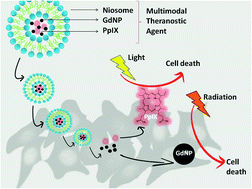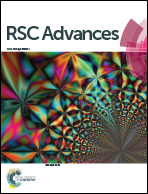Multimodal theranostic assemblies: double encapsulation of protoporphyrine-IX/Gd3+ in niosomes†
Abstract
Theranostic therapy is one of the most promising methods in cancer research, which simultaneously allows the treating and real-time monitoring of cancer. In the present study, a new method was developed to achieve advanced theranostic therapy by double encapsulation of gadolinium nanoparticles (GdNP) and protoporphyrin IX (PpIX) into niosomes. Hereby, niosomes are used for encapsulation of GdNP and PpIX, which will be called ‘Gd-PpIX-NI’. Niosomes are chosen as the encapsulation material owing to their high biocompatibility, physical and chemical stability, and fair price. On the other hand, GdNP and PpIX are good sensitizers for radiotherapy (RT) and, particularly, porphyrin structures are one of the most studied agents for photodynamic therapy (PDT). In this study, a multimodal treatment was performed with the combination of PDT and RT by using human alveolar type-II (ATII)-like cells (A549) and human cervical cancer cell line (HeLa). Moreover, ‘Gd-PpIX-NI’ serves as a dual cell imaging probe that provides both fluorescence and magnetic resonance imaging. Characterization of the sizes and zeta potential of the niosomal vesicles was carried out by dynamic light scattering and atomic force microscopy. To determine the cell viability after treatment with Gd-PpIX-NI, followed by PDT and RT application, the MTT method was used. The results showed that Gd-PpIX-NI assembling was homogeneous and consistent in terms of particle size, which is less than 100 nm. This material has potential as a good candidate for both PDT and RT, as well as diagnosis.


 Please wait while we load your content...
Please wait while we load your content...